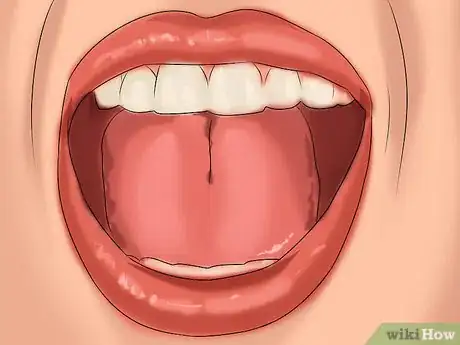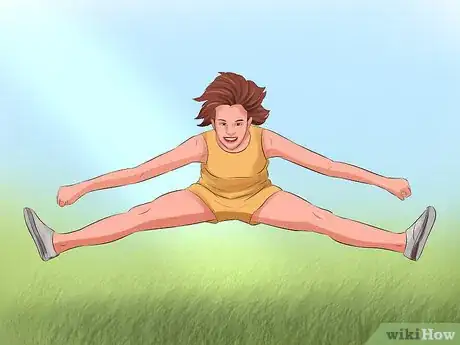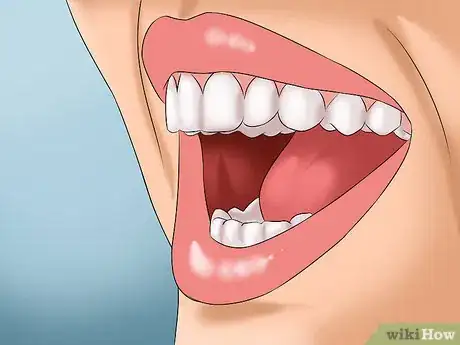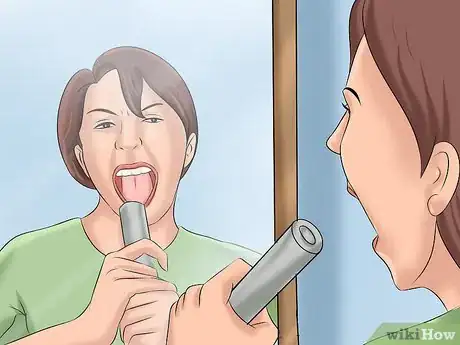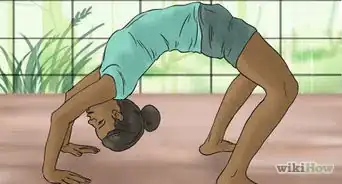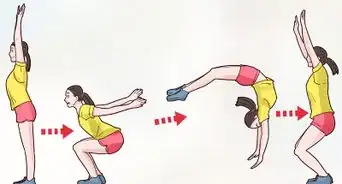This article was co-authored by Amy Chapman, MA. Amy Chapman MA, CCC-SLP is a vocal therapist and singing voice specialist. Amy is a licensed and board certified speech & language pathologist who has dedicated her career to helping professionals improve and optimize their voice. Amy has lectured on voice optimization, speech, vocal health, and voice rehabilitation at universities across California, including UCLA, USC, Chapman University, Cal Poly Pomona, CSUF, CSULA. Amy is trained in Lee Silverman Voice Therapy, Estill, LMRVT, and is a part of the American Speech and Hearing Association.
This article has been viewed 54,254 times.
An important part of being a great cheerleader is being loud and clear. Being loud and clear means prepping your voice, breathing properly, and strengthening your diaphragm. These are techniques that help to develop the tone and quality of your cheer voice.
Steps
Developing Your Breath and Voice
-
1Develop your breath and voice by strengthening your diaphragm. Use your diaphragm to project versus your actual vocal cords and do this by concentrating on using breath and voice from that area around your lungs.[1] Practice diaphragm exercises 5-10 minutes daily to help you strengthen your muscle for use during your cheering.[2]
- Lie down with your body flat against the ground. Make sure your knees are bent, as if you are in the resting position during crunches.
- Put one of your hands flat against your abs and the other one flat against your chest.
- Inhale your breath deeply through the nose. While doing this, make sure that your chest is completely still and that you are moving the stomach out.
- Exhale your breath through pursed lips. Pull your stomach in at the same time. Your chest should be still.
-
2Open up the back of your throat. Sound propels forward when you utilize the space behind your tongue as a resonance chamber.[3] To open up that area, practice yawning or pretend an egg is lodged in your throat. This will help you visualize where that area is and help you open it.[4]Advertisement
-
3Understand vocal placement. Projecting your voice is easier and quicker to do when you imagine a mask being there. This will help you concentrate on the area below your eyes and along your nose, which is where sound vibrations are easily felt.[5]
- Wear a Mardi Gras mask to help you further understand where you should be projecting your voice. The undereye area and the nose area is where you should feel vibrations when you speak.[6]
- Practice opening the throat (see previous step) while placing your voice forward toward the mask area.
-
4Put more energy into articulation. This causes your voice to lift up and away from throat muscles and into the resonators of your face instead. Projection happens because your sinus cavity and cheekbones create more resonance.[7]
-
5Add projecting to cardio. Practice being loud as you run because your cheer voice while you run makes you less tired and winded when it’s time for your actual cheer performances. Over time, this will help you become better at breath control while exerting yourself physically.
Speaking Clearly and Loudly
-
1Use breath control to talk in a clear, even voice. When all your air goes into one word or phrase, it results in a yell. Control how much air goes into each of your words by taking a deep breath so that you are able to deliver the rest of your chant evenly.[8]
- Using breath support like this will increase the volume of your words healthily versus straining them.
-
2
-
3Avoid yelling cheers and chants. Yelling causes damage to vocal cords by tightening them. Notice the tension and lack thereof when you yell versus project.
- To learn the difference between yelling words and projecting them, practice opening the diaphragm (as described in 1.1 above) to the rate of your airflow. This will help you learn the difference and protect your vocals.
- When you yell, you strain your vocals by causing them to tighten in an uncomfortable way. When you project, you are getting the same effect without the damage. Even though your words will be loud as you project, it will feel softer on your chords.[11]
Preparing to Use Your Cheer Voice
-
1Choose a cheer. Do cheers the team typically performs or create a cheer of your own using the school’s mascot and name. Practice by saying the cheer repeatedly to commit it to memory.
- Practice your chants with the moves in front of a mirror to get a better idea of how the crowd will see you.
-
2Warm up and warm down your voice. Use vocal warm ups to preserve your voice’s quality and prepare it for use.[12] Vocal warm ups should be done before vocally intensive activities, cheering being one of them.[13]
- Practice warming up your voice with tongue trills. Roll your tongue as if you are making the Spanish “r” sound. Vary the pitch up and down the scale while performing those “r” rolls.[14]
- Practice lip trills by placing your lips loosely together to release your breath in a steady stream. Releasing tension this way relieves the vocal cords.[15]
- Practice reciting your vowels (A, E, I, O, U) at different volumes. Practicing this with scales not only warms up your vocals, but it also helps with enunciation.
-
3Perform the moves that go along with the cheer. Cheerleading moves should be sharp and precise. Make sure you are executing the movements properly. You are not only representing you, but also your school and sports’ team as well.
-
4Use your voice in cheerleading. Spread cheer and promote crowd involvement by smiling and using your voice.
- Pronounce every word clearly through enunciation to initiate words and syllables smoothly.
- Wear a smile at all times and practice maintaining your poise. Team spirit must be felt the entire duration you’re cheering during games, win or lose.[16]
Community Q&A
-
QuestionWhat if my vocal chords break?
 Community AnswerYour vocal chords won't break; they're actually pretty strong. Projecting your voice may not even irritate them too much. If you want to prevent discomfort, try doing some vocal warm-ups, practice often, and stop if your throat feels tight or painful. Remember to project from your stomach and drink plenty of water.
Community AnswerYour vocal chords won't break; they're actually pretty strong. Projecting your voice may not even irritate them too much. If you want to prevent discomfort, try doing some vocal warm-ups, practice often, and stop if your throat feels tight or painful. Remember to project from your stomach and drink plenty of water.
Warnings
- When you feel you're losing your voice, take a rest. Straining your voice too much will lead to throat problems!⧼thumbs_response⧽
- Don't use alcohol or drugs.⧼thumbs_response⧽
- Some people do not have the wit or gut to be a cheerleader. If you really want to be one, you need to practice, practice, practice! If you're only looking for something to do, you should probably invest your time in something else, because cheerleading is probably not for you.⧼thumbs_response⧽
- Avoid eating chocolates or drinking milk before you cheer.⧼thumbs_response⧽
- Don't cheer while your voice is hoarse.⧼thumbs_response⧽
References
- ↑ http://www.kidzworld.com/article/26830-top-10-tips-for-cheerleading-tryouts
- ↑ Amy Chapman, MA. Voice Specialist. Expert Interview. 18 October 2019.
- ↑ http://www.enkivillage.com/how-to-project-your-voice.html
- ↑ http://www.enkivillage.com/how-to-project-your-voice.html
- ↑ http://www.enkivillage.com/how-to-project-your-voice.html
- ↑ http://www.enkivillage.com/how-to-project-your-voice.html
- ↑ http://www.enkivillage.com/how-to-project-your-voice.html
- ↑ Amy Chapman, MA. Voice Specialist. Expert Interview. 18 October 2019.
- ↑ Amy Chapman, MA. Voice Specialist. Expert Interview. 18 October 2019.
- ↑ http://www.personalitytutor.com/how-to-talk-loud.html
- ↑ http://www.personalitytutor.com/how-to-talk-loud.html
- ↑ Amy Chapman, MA. Voice Specialist. Expert Interview. 18 October 2019.
- ↑ http://www.entnet.org/content/vocal-warmup-put-your-best-voice-forward
- ↑ http://www.entnet.org/content/vocal-warmup-put-your-best-voice-forward
- ↑ http://www.entnet.org/content/vocal-warmup-put-your-best-voice-forward
- ↑ http://ericae.net/high-school-cheerleading.html


